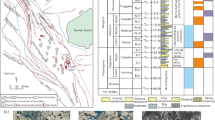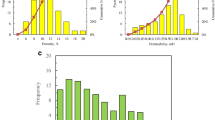Abstract
Predicting permeability from nuclear magnetic resonance (NMR) logging data using SDR model and Coates model provides a quick and relatively reasonable value for reservoir permeability estimate. Critical to these two models is to find contributions of different level of pore structure to permeability, but pore structure in them is only divided into two levels. In this study, T2 distribution is divided into several segments corresponding to different level of pore structure, and every segment has its weighted characteristic value. By this way, we have considered contributions of more different level of pore structure to permeability and established a new permeability model. It has been tested in dozens of core samples. Compared with results of Coates model and SDR model, the new NMR model result is more consistent with the air permeability. So, we provide an improved permeability estimate for low permeability and tight sandstone reservoir.













Similar content being viewed by others
References
Althaus Stacey M, Chen Jin-Hong, Zhang Jilin (2017) Permeability estimation of a Middle-East tight gas sand with NMR data. URTEC-2669857-MS Unconventional Resources Technology Conference, 24-26 July, Austin, Texas, USA, 2017
Amyx JW, Bass DW Jr, Whiting RL (1960) Petroleum reservoir engineering. Mc Graw Hill Publ. Co., New York, NY
Carman PC (1956) Flow of gases through porous media. Academic Press Inc., Butterworths, London
Coates GR, Peveraro RCA, Hardwick A, Roberts D (1991) The magnetic resonance imaging log characterized by comparison with petrophysical properties and laboratory core data, paper 22723, proceedings of the society of petroleum engineers 66th annual technical conference and exhibition.
Coates GR, Xiao L, Prammer MG (1999) NMR logging: principles and applications. Haliburton Energy Services, Houston
Dastidar R, Sondergeld CH, Rai CS (2007) An improved empirical permeability estimator from mercury injection for tight clastic rocks. Petrophysics 48(3):186–190
Dlubac Katherine, Knight Rosemary (2010) An assessment of the use of the Kozeny-Carman Relationship to estimate permeability in anisotropic materials from NMR data. SEG Annual Meeting, 17-22 October, Denver, Colorado, 2010
Granberry RJ and Keelan DK (1977) Critical water estimates for gulf coast sands, transactions gulf coast association of geological societies, 63–66
Hearst JR, Nelson PH (1985) Well Logging for Physical Properties. Mc Graw Hill Publ. Co., New York, NY
Hiller T, Klitzsch N (2018) Joint inversion of nuclear magnetic resonance data from partially saturated rocks using a triangular pore model. Geophysics 83(4):JM15–JM28
Huet CC (2005) A modified Purcell/Burdine model for estimating absolute permeability from mercury-injection capillary pressure data, IPTC 10994, the International Technology Conference held in Doha Qatar, 21-23 November, 2005
Katz AJ, Thompson AH (1986) Quantitative prediction of permeability in porous rock. Phys Rev B 34(11):8179–8181
Kenyon WE (1997) Petrophysical principles of application of NMR logging, the log analyst 38(2):21-43
Kenyon WE, Day PI, Straley C, Willemsen JF (1988) A three-part study of nmr longitudinal relaxation properties of watersaturated sandstones. SPE Form Eval 3(3):622–636
Latour LL, Kleinberg RL, Mitra PP (1995) Pore-size distributions and tortuosity in heterogeneous porous media. J Magn Reson Ser A 112:83–91
Li X, Kang Y, Haghighi M (2018) Investigation of pore size distributions of coals with different structures by nuclear magnetic resonance (NMR) and mercury intrusion porosimetry (MIP). Measurement 116:122–128
Nelson PH (2005) Permeability, porosity, and pore-throat size–a three-dimensional perspective. Petrophysics 48(3):186–190
Paterson MS (1983) The equivalent channel model for permeability and resistivity in fluid-saturated rock — a re-appraisal. Mech Mater 2:345–352
Philip HN (1994) Permeability-porosity relationships in sedimentary rocks. Log Anal 1994:38–62
Purcell WR (1949) CApillary pressures - their measurement using mercury and the calculation of permeability therefroM. SPE 949039-G, February, 1949
Romero Pedro, Salvador BA (2004) Method for characterization of rock quality based on Winland-Pittman and Timus-Coates equations applied to NMR laboratory data. SPWLA 45th Annual Logging Symposium, June 6-9, 2004
Salah Ahmed (2012) The impact of pore geometry aspects on porosity-permeability relationship - a critical review to evaluate NMR estimated permeability. SPE150887, the North Africa Technical Conference and Exhibition held in Cairo, Egypt, 20-22, February 2012
Sigal R (2002) Coates and SDR permeability: two variations on the same theme. Petrophysics 43(1):38–46
Susilo Agus (2010) Permeability prediction based on capillary model. SPE 141122-STU, SPE Annual Technical Conference and Exhibition held in Florence, Italy, 19-22 September 2010
Swanson BF (1981) A simple correlation between permeabilities and mercury capillary pressures, SPE 8234-PA, Society of Petroleum Engineers of AIME, 1981
Tariq Syed M, Denoo Stan, Cordes Mo (1997) Permeability estimation from modern NMR logging measurements: experiences and applications in the rocky mountain area. SPE-38378-MS, 2017
Timur A (1968) An investigation of permeability, porosity, and residual water saturation relationships for sandstone reservoirs. Log Anal 9(4):8–17
Volokitin Yakov, Looyestijin Wim, Slijkerman Walter (1999) Constructing capillary pressure curves from nmr log data in the presence of hydrocarbons. SPWLA 40th Annual Logging Symposium, May 30-June 3, 1999
Wall CG (1965) Permeability: pore size distribution correlations. J Inst Petrol 51:498
Walsh JB, Brace WF (1984) The Effect of Pressure on Porosity and the Transport Properties of Rock. J Geophys Res 89(11):9425–9431
Acknowledgments
The authors wish to thank Petrochina for allowing us to publish the study. We would like to thank Changqing Oilfield for providing us core samples.
Funding
This work was supported by the Petrochina scientific research project: Far detecting acoustic logging processing method & Joint inversion research of dielectric scanner logging and NMR logging (No: kt2018-10-07).
Author information
Authors and Affiliations
Corresponding author
Additional information
Responsible Editor: Liang Xiao
Rights and permissions
About this article
Cite this article
Xu, H., Li, C., Fan, Y. et al. A new permeability predictive model based on NMR data for sandstone reservoirs. Arab J Geosci 13, 1085 (2020). https://doi.org/10.1007/s12517-020-06055-6
Received:
Accepted:
Published:
DOI: https://doi.org/10.1007/s12517-020-06055-6




